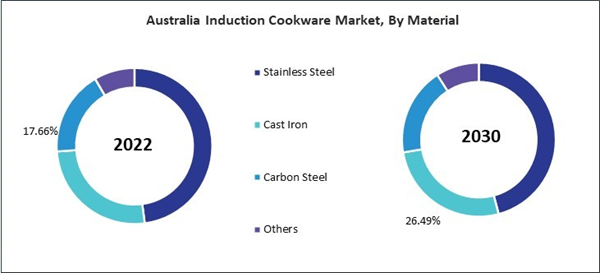In commercial settings, induction cookware has become integral due to its diverse uses, efficiency, and numerous advantages. Restaurants, catering services, and other commercial kitchens extensively utilize it for tasks ranging from boiling and frying to precise temperature-controlled cooking methods. Therefore, the Australia cookware market consumed 517.49 thousand units in 2022.
The China market dominated the Asia Pacific Induction Cookware Market by Country in 2022, and would continue to be a dominant market till 2030; thereby, achieving a market value of $314.6 million by 2030. The Japan market is showcasing a CAGR of 6.6% during (2023 - 2030). Additionally, The India market would register a CAGR of 8% during (2023 - 2030).
This is becoming increasingly popular among customers as they become more conscious of environmental issues and focus more on living sustainably. Induction cookware’s energy efficiency contributes to lower carbon emissions, making it an attractive option for environmentally conscious individuals seeking to reduce their ecological footprint.
Additionally, absence of open flames also minimizes the release of pollutants into the air, further aligning with green living principles. Safety considerations play a pivotal role in the adoption of it.
Additionally, the ease of cleaning and maintenance associated with induction cooktops resonates with busy lifestyles, where consumers value appliances that simplify household chores and save time. The adoption of this is influenced by changing culinary trends and a growing interest in diverse cooking techniques.
According to the report titled Cities as Engines of Growth, published in 2022 by the Government of India, the population of urban areas in India is projected to have increased approximately fourfold, from 109 million in 1970 to 460 million in 2018. The country is projected to experience an additional 416 million inhabitants in its urban areas by 2050, resulting in a 50 percent urban population share. It is already the second-largest urban community.
Based on Application, the market is segmented into Residential, and Commercial. Based on Product, the market is segmented into Pans, Pots, and Others. Based on Material, the market is segmented into Stainless Steel, Cast Iron, Carbon Steel, and Others. Based on Distribution Channel, the market is segmented into Supermarkets/Hypermarkets, Specialty Stores, Online, and Others.Based on countries, the market is segmented into China, Japan, India, South Korea, Australia, Malaysia, and Rest of Asia Pacific.
List of Key Companies Profiled
- Groupe SEB
- Meyer Corporation, U.S. (Meyer Manufacturing Co. Ltd.)
- Le Creuset France SAS
- Newell Brands, Inc.
- Whirlpool Corporation
- Robert Bosch GmbH
- TTK Prestige Limited
- Wilh.Werhahn KG
- Fissler GmbH
- Tramontina
Market Report Segmentation
By Application (Volume, Thousand Units, USD Billion, 2019-2030)- Residential
- Commercial
- Pans
- Pots
- Others
- Stainless Steel
- Cast Iron
- Carbon Steel
- Others
- Supermarkets/Hypermarkets
- Specialty Stores
- Online
- Others
- China
- Japan
- India
- South Korea
- Australia
- Malaysia
- Rest of Asia Pacific
Table of Contents
Companies Mentioned
- Groupe SEB
- Meyer Corporation, U.S. (Meyer Manufacturing Co. Ltd.)
- Le Creuset France SAS
- Newell Brands, Inc.
- Whirlpool Corporation
- Robert Bosch GmbH
- TTK Prestige Limited
- Wilh. Werhahn KG
- Fissler GmbH
- Tramontina
Methodology

LOADING...









